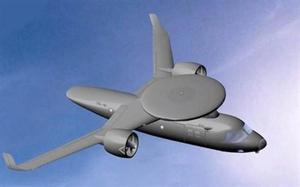In the trenchesBoeing shows a plane-helicopter combo
The DARPA-funded, Boeing-developed DiscRotor combines the hovering ability and landing control of a helicopter with the high-speed, high-altitude flight capabilities of a plane, something that could be of use especially in military situations

Artist's rendering of a discrotor-powered aircraft // Source: aviationweek.com
The CSAR DiscRotor, a collaboration between Boeing and DARPA, was approved back in 2008, and now there is a YouTube animated video of it.
The DiscRotor combines the hovering ability and landing control of a helicopter with the high-speed, high-altitude flight capabilities of a plane, something that could be of use especially in military situations. A helicopter can get places a plane can not, since it does not need a landing strip or particularly smooth terrain, but even high-speed helicopters are much slower and more vulnerable in the air.
DARPA says this kind of vehicle “provides survivability, mobility, and responsiveness for troop and cargo insertion.” Graham Warwick writes in Aviation Week that the blades are fragile and create unwanted drag, which is why engineers have not just placed a helicopter blade onto an airplane.
The blades of the DiscRotor retract into a flat disc, which can in turn be used as another wing when the craft is flying like a plane. At that point, it is powered by two traditional turbo-shaft engines underneath each wing, and flies more or less like a typical plane. The main problem is that the vehicle needs to be able to transition from plane mode to helicopter mode reliably and smoothly while in the air, and the in-air forces make that difficult. Boeing notes that that is only one of “several large technical challenges.”
The DiscRotor is in phase 1b of DARPA’s testing; a model will undergo wind tunnel testing in 2011.
